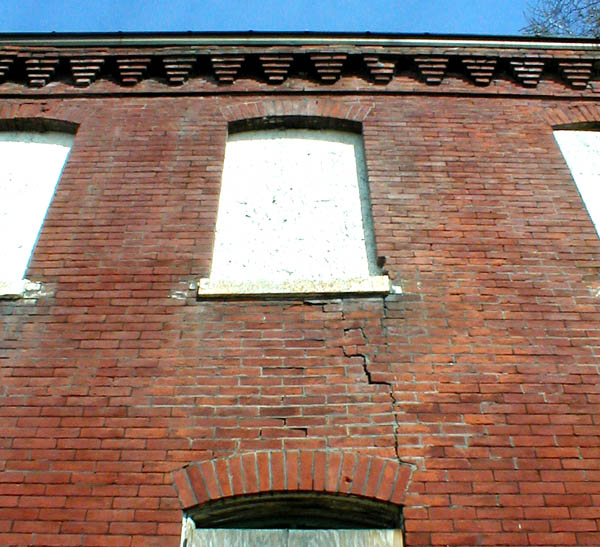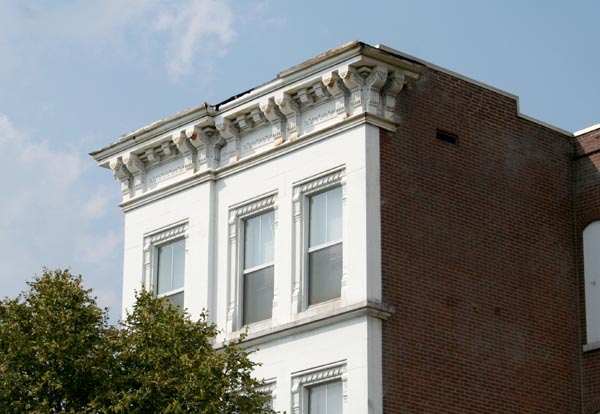It 189 posts to do it, 189 days -- that's over half a year. But the actual number of buildings is far higher. Some of those posts covered multiple buildings; a few included entire city blocks. If I had to take a stab at it, I'd guess the total number of buildings is closer to 400, or higher. Four hundred buildings! And that doesn't begin to cover all the vacant land McKee has bought... some of which wasn't vacant when he bought it.
(It is possible that I have missed a few, and if so, I invite site readers to point them out. They will be added as soon as possible. Also of note, I did not include the demolished Brecht Butcher Supply Warehouse in Old North, nor the crumbling James Clemens mansion in St. Louis Place.)

The bulk of those buildings are St. Louis housing stock, sturdy red brick buildings built between 1880 and 1930. Some are plain; many have beautiful decoration and ornament. Some are outright spectacular.
Some of those houses were abandoned when McKee purchased them; a few were badly deteriorated. Many were occupied. Some owner-occupants sold out willingly, lured by money or fearful of eminent domain taking everything they had. Many renters had no choice, and were forcibly ejected from their homes.

Under Paul McKee's ownership, the vast majority of these houses have deteriorated. This deterioration occurs due to more than simple lack of maintenance; much of it is due to willful neglect:
- Many have had their windows removed. There is no reason to do this other than to hasten the decline of the houses.
- Many have been attacked and destroyed by brick rustlers. If Blairmont had left tenants in place, if they had monitored their properties, if they had not worked to empty out entire blocks, this could not have happened.
- A rash of Blairmont's buildings were destroyed by fire, mostly likely arson. Again, a vacated neighborhood is far less likely to have such problems.
- Most have not been boarded up, or had their grounds maintained, making it obvious that they are vacant. This allows them to become havens for criminal activities.

This blog and web site are about architecture; my focus is on the buildings of these neighborhoods. But the human dimension is still more important, even if it is often hidden, more easily swept under the carpet. And in dealing with the human beings whose neighborhood this is, Paul McKee Jr. has been just as willfully abusive and negligent as he has been with the city's architectural legacy:
- He has attempted to operate in total secrecy.
- He has refused to come forward and declare his plan for the area.
- He has refused to solicit input from those living in the area.
- Despite his claims to the contrary, he has bought many occupied buildings, evicting the tenants and thereby diminishing the population of the area.
- He has issued contradictory and ultimately false statements regarding his plans.
- He has stood by and done nothing with his properties, even as new development rises around many of them.

The most maddening aspect, however, is that it did not have to be this way. There appears to be no reason for McKee's destructive, terrorizing, blockbusting tactics other than willful stubbornness, combined with a blind conviction that wholesale destruction is the only way to rejuvenate a neighborhood.
The most cursory glance at St. Louis's 20th century history readily demonstrates how obsolete and backward these convictions are. Time and again, total clearance has produced only misery, failure, and worsening conditions for those upon whom it is inflicted. It does not solve any problems; it simply shuffles them somewhere else.
Total clearance destroys more than architecture; it destroys neighborhoods. It destroys people's homes. It destroys the localized environment that support small, independent businesses. It destroys social ties. It destroys a web of human connections, of intertwined lives and support networks. This sort of human connection may be hard to grasp for those who have never experienced it, for those who live in isolated suburbs and travel only by car, but it's a defining aspect of urban neighborhoods, and is vital to the survival and well-being of their residents.

The destructive approach has characterized everything McKee has done in north St. Louis. He has destroyed architecture, urban fabric, neighborhoods, homes. He seems dead set on wiping the slate clean, improving the neighborhood by destroying it.
How would you like it if someone with a lot more wealth and power than you came in, decided that your neighborhood wasn't good enough, and started working to destroy it? Not to improve it, but to destroy it!
And what becomes of the residents who are forced out of their homes? They are rarely if ever accounted for, especially if they are low-income. They are shuffled on to another place, another neighborhood, where, lacking their previous support network, they must struggle harder still to survive. If they are unable to gather sufficient resources, the new neighborhood may begin to decline. In exploding the neighborhoods of St. Louis Place and JeffVanderLou, Paul McKee is doing no favors for the poor.

What could Mr. McKee have done instead? What would make me and other urbanists happy? What would actually improve the lives of people living here?
- Selective redevelopment. This would be especially welcome in Old North St. Louis, which is slowly but surely redeveloping itself. McKee has spent enough money to renovate every single one of his Old North properties, and doing so would have made him a hero to the neighborhood's residents. Instead, he's regarded as a slumlord and worse, and he hasn't made a dime on his investment.
- Selective land aggregation and clearance. There are some areas in these neighborhoods that could, with just a few purchases and buyouts, be assembled into large blank canvases for new development. With so many opportunities, there is no need to destroy entire blocks and create damaging voids in healthy blocks.
- Respect existing urban fabric. Plan to build around surviving historic houses. Offer financial assistance to the owners of those houses if they wish to upgrade and improve their properties. Enact a preservation plan. Acknowledge that this is the city, not the suburbs, and plan accordingly.

I must repeat: I want to see development happen in these neighborhoods. I am not trying to discourage it. These areas need new construction and new residents. Nor am I trying to deny their problems. They had many troubles before Blairmont came along, and they would still have troubles if Paul McKee had never set foot in them. But Blairmont's work has visibly made things worse, not better, and so far there has been no payoff whatsoever for all the damage done.
As I try to take stock of Paul McKee's tactics, I find myself unable to grasp his plans, unable to understand what it is that he wants to do. There are only a few possibilities, and all of them defy logic:
- A suburban-styled development, perhaps with some token concessions toward New Urbanism, perhaps gated, maybe with a golf course. This would explain what appears to be a drive toward total site control. However, it would require unfathomable amounts of demolition -- not just of the remaining historic stock, but of extensive new construction in numerous locations in all three neighborhoods. Furthermore, even controlling all of JeffVanderLou, Old North, and St. Louis Place will not sanitize the remaining areas around them. It will not transform Hyde Park. It will not make the eastern Ville any less rough. Even if such a thing belonged in a city, the idea that an untouchable enclave could be created on McKee's land is simply a fantasy. Furthermore, if it could be done, why not go ahead and do it on the empty acres of the former Pruitt-Igoe site just to the south?
- Light industry. This would make some sense for the area; it's more easily defended and can co-exist with empoverished neighborhoods. But if that's the plan... why the hell hasn't he already done it?! Again, the Pruitt-Igoe site begs for new development. The 23rd Street prairie contains vast amounts of empty land. The endless game of buy-and-wait, buy-and-wait, buy-and-wait defies all notions of conventional development; McKee is pouring huge sums of money into property acquisition, and has yet to see a penny in return after three years.
- Mississippi River Bridge clearance. I don't know exactly where the new bridge is supposed to come through, but it could affect a few of McKee's properties. But that bridge is years away... if it happens at all.

I don't know what Paul McKee is planning. It seems like nobody does. And this uncertainty is a cruel burden to place on those who call JeffVanderLou, St. Louis Place, and Old North home.
It is long past time for McKee to come forward and publicly announce his plans, meet with residents, and take action on his long-neglected properties.

- More on Blairmont:
Built St. Louis || Ecology of Absence || What Can I Do?












































